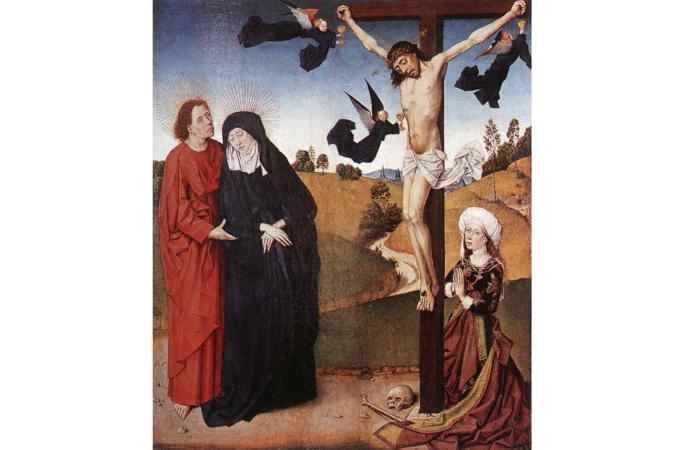Mother of Mercy
On Sunday, we begin the month of May, traditionally dedicated to the Blessed Virgin Mary. It's an opportunity for us, during this extraordinary Jubilee of Mercy, to grow in conscious devotion to her as Mother of Mercy. It's a chance to enter her "school" and learn from her how to recognize our need for, come to receive, and imitate and extend the mercy her Son brought into the world.
At the end of his letter for the Year of Mercy, Misericordiae Vultus, Pope Francis turned to Mary as "Mother of Mercy" and affirmed, "Her entire life was patterned after the presence of mercy made flesh," evoking Jesus' self-description in his revelations to St. Faustina as "Mercy incarnate."
We see the depth of Mary's exemplification and participation in her Son's mission of mercy on Calvary, in Jesus' first three words on the Cross: his prayers for sinners in general, "Father, forgive them for they know not what they do"; his care for one sinner, the Good Thief, in particular, "Today you will be with me in Paradise"; and then his entrustment of each of us sinners to her maternal merciful care as he told her, "Behold your son," and told us, "Behold your mother."
"At the foot of the Cross," Pope Francis emphasized in a homily celebrating Mary's Maternity this Jan. 1, "Mary became for all of us the Mother of forgiveness. Following Jesus' example and by his grace, she herself could forgive those who killed her innocent Son. For us, Mary is an icon of how the Church" -- how you and I in the Church -- "must offer forgiveness to those who seek it," adding, "The Church's forgiveness must be every bit as broad as that offered by Jesus on the Cross and by Mary at his feet."
The Church has long related to Mary by invoking her merciful love.
In the Rosary, as we meditate on the principal mysteries of salvation history, we ask her not once, not twice, but 53 times, "Holy Mary, Mother of God, pray for us sinners, now and at the hour of our death."
In the Hail Holy Queen, we entreat her as "Mother of Mercy!" and "O Clement" and beg her as our "most gracious advocate" to turn her "eyes of mercy toward us" and "after this our exile" to "show us the blessed fruit of [her] womb, Jesus," the enfleshment of God's mercy.
In the beautiful hymn, Alma Redemptoris Mater that the Church sings to her during the Advent and Christmas Seasons, we invoke her as the "Sweet Mother of the Redeemer" and implore, "Have mercy on us sinners!" and "Hasten to aid your fallen people who strive to rise once more."
In the Litany of Loreto, we turn to her as "Virgin most merciful," as "Refuge of Sinners" and as "Help of Christians," asking her repeatedly to "pray for us."
Through the Church's evening daily chanting of the "Magnificat" Mary prophetically exclaimed during the Visitation, we learn how to let our souls praise and spirits rejoice in God our savior whose "mercy is from generation to generation toward those who fear him" and who "remembers his mercy ... promised to our Fathers."
Over the last 500 years, through the many apparitions that the Church has investigated and found worthy of belief, Mary has continued what can only be described as her unique Mission of Mercy.
When she appeared to St. Juan Diego in Tepeyac in 1531, she said to him, "I am truly your merciful Mother" and indicated that she wanted a teocalli, a shrine, built where she could "hear [her sons' and daughters'] weeping, their complaints and heal all their sorrows, hardships and sufferings."
During her 18 appearances in Lourdes to St. Bernadette in 1858, she identified herself as the fulfillment of what God had prophesied at the beginning of time, when he said that he would put "enmity" between the serpent and "the woman" (Gen 3:16), saying, "I am the Immaculate Conception" -- I am, in other words, the one free from sin -- and asked St. Bernadette to join her in praying for mercy saying, ""Penance! Penance! Pray to God for sinners. Kiss the ground as an act of penance for sinners!" When St. John Paul II went to Lourdes to celebrate the 125th anniversary of the apparitions in 1983, he memorably summarized her unceasing celestial task: "The Virgin without sin brings help to sinners."
When she appeared to Jacinta, Francisco and Lucia in Fatima in 1917, she asked them to join her in praying and sacrificing for the conversion of sinners, that they be "saved from the fires of hell" and that "all souls be brought to heaven, especially those in most need of [God's] mercy." She asked them to have everyone consecrate themselves to her Immaculate Heart so that their heart might be like hers, full of mercy, full of grace, and enter into her own fiat and triumph.
Mary's Mission of Mercy is ongoing and doubtless intensified during this Jubilee Year.
St. John Paul II wrote about her in his beautiful encyclical on God's mercy, that she "is the one who has the deepest knowledge of the mystery of God's mercy. She knows its price, she knows how great it is. In this sense, we call her the Mother of Mercy, our Lady of Mercy, or Mother of Divine Mercy."
In a special way during the month of May during this extraordinary Jubilee, we not only invoke her maternal love under those titles but seek to learn from her the knowledge, price and greatness of her Son's greatest gift.
- Father Roger J. Landry is a priest of the Diocese of Fall River, Massachusetts, who works for the Holy See’s Permanent Observer Mission to the United Nations.



















